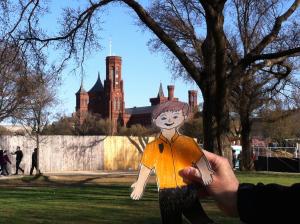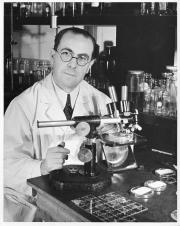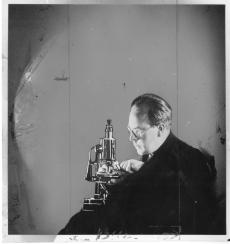 Like thousands of other aunts, uncles, cousins, and grandparents, my husband and I recently wandered through Smithsonian museums as we photographed a paper cutout. In our case, "Flat John" had traveled from a second-grade classroom in Missouri and is now back home with many tales of an "adventure" in Washington, D.C.
Like thousands of other aunts, uncles, cousins, and grandparents, my husband and I recently wandered through Smithsonian museums as we photographed a paper cutout. In our case, "Flat John" had traveled from a second-grade classroom in Missouri and is now back home with many tales of an "adventure" in Washington, D.C.
Although poor Flat John could not pull or push the mechanical and electronic devices in the exhibitions he visited, his fellow (human) visitors, large and small, could – and did – with gusto. A century ago, Smithsonian exhibitions featured passive displays. Now, in every museum along the National Mall, adults and children watch videos, listen to exhibition narration on their smartphones, and touch screens in order to "interact" with the artifacts.
 One of the pioneers in introducing such action to science museums was George Roemmert (1892-1952). His most famous development, the "Microvivarium," projected images of amoebas, infusoria, and other animalcules placed underneath a special microscope. In 1933 and 1934, Roemmert's display became such a hit at the Century of Progress International Exposition in Chicago that local newspapers recommended that visitors skip the more commercial displays and head first to the Hall of Science.
One of the pioneers in introducing such action to science museums was George Roemmert (1892-1952). His most famous development, the "Microvivarium," projected images of amoebas, infusoria, and other animalcules placed underneath a special microscope. In 1933 and 1934, Roemmert's display became such a hit at the Century of Progress International Exposition in Chicago that local newspapers recommended that visitors skip the more commercial displays and head first to the Hall of Science.
The public's newfound fascination with motion pictures undoubtedly contributed to the popularity of the Microvivarium. Here, as in the films of Jean Painlevé, one could watch and wonder at a world in miniature. Worms, larvae, and water-fleas swirled, swam, and swallowed each other within the huge circles of light created by six projectors.
![left to right: George Roemmert (1892-1952) and Bertha Benaburger Roemmert, 1934, Smithsonian Institution Archives, SIA Acc. 90-105 [SIA2009-2398]. left to right: George Roemmert (1892-1952) and Bertha Benaburger Roemmert](https://ids.si.edu/ids/iiif/SIA-SIA2009-2398-000001/full/180,/0/default.jpg)
 Roemmert's Microvivarium exemplified the excitement that Science Service wanted to associate with popularization of science. Thone therefore became caught up in the inventor's search for a permanent installation – no small task in the midst of an economic depression. Thone brokered a demonstration at the Cosmos Club in Washington, D.C., and he introduced Roemmert to William Mann, Director of the National Zoological Park, and other Smithsonian Institution scientists. Discouraged by his failure to interest any Chicago museum in offering a permanent home, in 1935 Roemmert returned to New York, where he continued negotiations with the American Museum of Natural History. Its offer, however, did not include more than nominal salary for Roemmert and the museum never had sufficient funds to support installation.
Roemmert's Microvivarium exemplified the excitement that Science Service wanted to associate with popularization of science. Thone therefore became caught up in the inventor's search for a permanent installation – no small task in the midst of an economic depression. Thone brokered a demonstration at the Cosmos Club in Washington, D.C., and he introduced Roemmert to William Mann, Director of the National Zoological Park, and other Smithsonian Institution scientists. Discouraged by his failure to interest any Chicago museum in offering a permanent home, in 1935 Roemmert returned to New York, where he continued negotiations with the American Museum of Natural History. Its offer, however, did not include more than nominal salary for Roemmert and the museum never had sufficient funds to support installation.
 Roemmert's struggle to find a home for an acknowledged success mirrored the dilemma long faced by popular science projects. "Public institutions everywhere, however great their interest," he acknowledged to Thone, "are hampered by a lack of funds."
Roemmert's struggle to find a home for an acknowledged success mirrored the dilemma long faced by popular science projects. "Public institutions everywhere, however great their interest," he acknowledged to Thone, "are hampered by a lack of funds."
Such setbacks left Roemmert amenable to a pragmatic decision in December 1937. The Westinghouse Electric Company wanted the Microvivarium as the main feature of their hall in the 1939 New York World's Fair. Abandoning his dream of a non-commercial venue, Roemmert agreed to the company's terms, which allowed him to retain freedom in the laboratory and in how the Microvivarium was exhibited.
And so, when you next enjoy a lively science exhibition (perhaps accompanied by your own "flat" tourist), take a moment to remember George Roemmert, whose vision of popularization added a new dramatic dimension to biology. In the Microvivarium, Thone wrote, "single cells loom big as bushel baskets, [and] microscopic animalcule are as large and as lively as jackrabbits."
Related Collections
- Record Unit 7091 - Science Service, Records, circa 1910-1963, Smithsonian Institution Archives
- Accession 90-105 - Science Service, Records, 1920s-1970s, Smithsonian Institution Archives
Produced by the Smithsonian Institution Archives. For copyright questions, please see the Terms of Use.

Leave a Comment